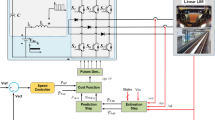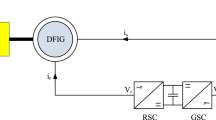Abstract
Low-voltage ride through (LVRT) is important for system compensation and reliable operation of the system during balance and unbalanced voltage dips. In this study, a new LVRT capability method was developed using active and passive compensator in doubly fed induction generator (DFIG)-based wind turbines. While the active compensator provides the control of the rotor-side converter and grid-side converters of DFIG, the passive compensator decreases the stator and rotor over currents and injects reactive power into the network to support the grid voltage DFIG. Besides, rotor electromotive force is developed to improve LVRT capability against not only symmetrical but also asymmetrical faults of DFIG. It was found that the system became stable in a short time and oscillations damped using active and passive compensator modeling.








Similar content being viewed by others

References
Abad G, Lopez J, Rodriguez M, Marroyo L, Iwanski G (2011) Doubly fed induction machine: modeling and control for wind energy generation, vol 85. Wiley, New York
Abbey C, Joos G (2007) Supercapacitor energy storage for wind energy applications. IEEE Trans Ind Appl 43(3):769–776
Döşoğlu MK (2016a) A new approach for low voltage ride through capability in DFIG based wind farm. Int J Electr Power Energy Syst 83:251–258
Döşoğlu MK (2016b) Hybrid low voltage ride through enhancement for transient stability capability in wind farms. Int J Electr Power Energy Syst 78:655–662
Döşoğlu MK (2017a) Enhancement of SDRU and RCC for low voltage ride through capability in DFIG based wind farm. Electr Eng 99(2):673–683
Döşoğlu MK (2017b) Nonlinear dynamic modeling for fault ride-through capability of DFIG-based wind farm. Nonlinear Dyn 89(4):2683–2694
Döşoğlu MK, Arsoy AB (2016) Enhancement of a reduced order doubly fed induction generator model for wind farm transient stability analyses. Turk J Electr Eng Comput Sci 24(4):2124–2134
Döşoğlu MK, Güvenç U, Sönmez Y, Yılmaz C (2018) Enhancement of demagnetization control for low-voltage ride-through capability in DFIG-based wind farm. Electr Eng 100(2):491–498
Ekanayake JB, Holdsworth L, Jenkins N (2003) Comparison of 5th order and 3rd order machine models for doubly fed induction generator (DFIG) wind turbines. Electr Power Syst Res 67(3):207–215
Flannery PS, Venkataramanan G (2008) A fault tolerant doubly fed induction generator wind turbine using a parallel grid side rectifier and series grid side converter. IEEE Trans Power Electron 23(3):1126–1135
Gounder YK, Nanjundappan D, Boominathan V (2016) Enhancement of transient stability of distribution system with SCIG and DFIG based wind farms using STATCOM. IET Renew Power Gener 10(8):1171–1180
Huang S, Wu Q, Guo Y, Rong F (2019) Optimal active power control based on MPC for DFIG-based wind farm equipped with distributed energy storage systems. Int J Electr Power Energy Syst 113:154–163
Kasem AH, El-Saadany EF, El-Tamaly HH, Wahab MAA (2008) An improved fault ride-through strategy for doubly fed induction generator-based wind turbines. IET Renew Power Gener 2(4):201–214
Krause PC (2002) Analysis of electric machinery, 2nd edn. McGraw-Hill, New York
Liang J, Harley RG (2011) Feed-forward transient compensation control for DFIG wind generators during both balanced and unbalanced grid disturbances. In: IEEE energy conversion congress and exposition (ECCE), pp 2389–2396
Liang J, Qiao W, Harley RG (2010) Feed-forward transient current control for low-voltage ride-through enhancement of DFIG wind turbines. IEEE Trans Energy Convers 25(3):836–843
Mirzakhani A, Ghandehari R, Davari SA (2019) Modeling and dynamic response of double-feed induction generator and back-to-back converters in unbalanced grid voltage conditions. Wind Eng. https://doi.org/10.1177/0309524X19849857
Mohammadi J, Afsharnia S, Vaez-Zadeh S (2014) Efficient fault-ride-through control strategy of DFIG-based wind turbines during the grid faults. Energy Convers Manag 78:88–95
Mohammadi J, Afsharnia S, Vaez-Zadeh S, Farhangi S (2016) Improved fault ride through strategy for doubly fed induction generator based wind turbines under both symmetrical and asymmetrical grid faults. IET Renew Power Gener 10(8):1114–1122
Mohseni M, Islam SM (2012) Transient control of DFIG-based wind power plants in compliance with the Australian grid code. IEEE Trans Power Electron 27(6):2813–2824
Rahimi M, Azizi A (2019) Transient behavior representation, contribution to fault current assessment, and transient response improvement in DFIG-based wind turbines assisted with crowbar hardware. Int Trans Electr Energy Syst 29(1):e2698
Rahimi M, Parniani M (2010) Efficient control scheme of wind turbines with doubly fed induction generators for low-voltage ride-through capability enhancement. IET Renew Power Gener 4(3):242–252
Rahimi M, Parniani M (2014) Low voltage ride-through capability improvement of DFIG-based wind turbines under unbalanced voltage dips. Int J Electr Power Energy Syst 60:82–95
Rashad A, Kamel S, Jurado F, Abdel-Nasser M, Mahmoud K (2019) ANN-based STATCOM tuning for performance enhancement of combined wind farms. Electr Power Compon Syst 47:1–17
Rezaie H, Kazemi-Rahbar MH (2019) Enhancing voltage stability and LVRT capability of a wind-integrated power system using a fuzzy-based SVC. Eng Sci Technol Int J 22(3):827–839
Sitharthan R, Sundarabalan CK, Devabalaji KR, Nataraj SK, Karthikeyan M (2018) Improved fault ride through capability of DFIG-wind turbines using customized dynamic voltage restorer. Sustain Cities Soc 39:114–125
Slootweg JG, Polinder H, Kling WL (2011) Dynamic modelling of a wind turbine with doubly fed induction generator. In: IEEE power engineering society summer meeting, pp 644–649
Wu F, Zhang XP, Godfrey K, Ju P (2007) Small signal stability analysis and optimal control of a wind turbine with doubly fed induction generator. IET Gener Transm Distrib 1(5):751–760
Xiao S, Yang G, Zhou H, Geng H (2013) An LVRT control strategy based on flux linkage tracking for DFIG-based WECS. IEEE Trans Ind Electron 60(7):2820–2832
Yang L, Xu Z, Ostergaard J, Dong ZY, Wong KP (2012) Advanced control strategy of DFIG wind turbines for power system fault ride through. IEEE Trans Power Syst 27(2):713–722
Yao J, Li H, Chen Z, Xia X, Chen X, Li Q, Liao Y (2013) Enhanced control of a DFIG-based wind-power generation system with series grid-side converter under unbalanced grid voltage conditions. IEEE Trans Power Electron 28(7):3167–3181
Zheng Z-X et al (2019) A low voltage ride through scheme for DFIG-based wind farm with SFCL and RSC control. IEEE Trans Appl Supercond 29(2):1–5
Zhou D, Blaabjerg F (2018) Optimized demagnetizing control of DFIG power converter for reduced thermal stress during symmetrical grid fault. IEEE Trans Power Electron 33(12):10326–10340
Author information
Authors and Affiliations
Corresponding author
Rights and permissions
About this article
Cite this article
Döşoğlu, M.K. Enhancement of Dynamic Modeling for LVRT Capability in DFIG-Based Wind Turbines. Iran J Sci Technol Trans Electr Eng 44, 1345–1356 (2020). https://doi.org/10.1007/s40998-020-00313-9
Received:
Accepted:
Published:
Issue Date:
DOI: https://doi.org/10.1007/s40998-020-00313-9



